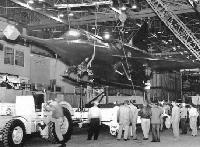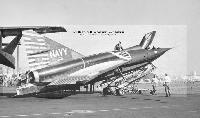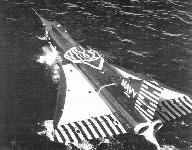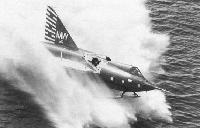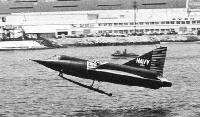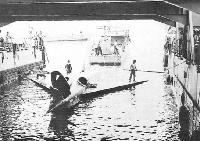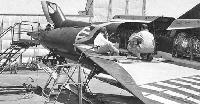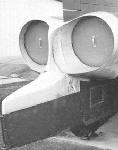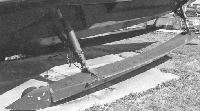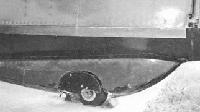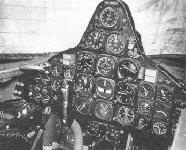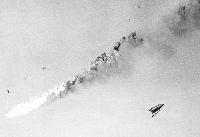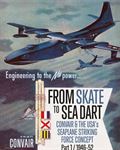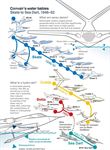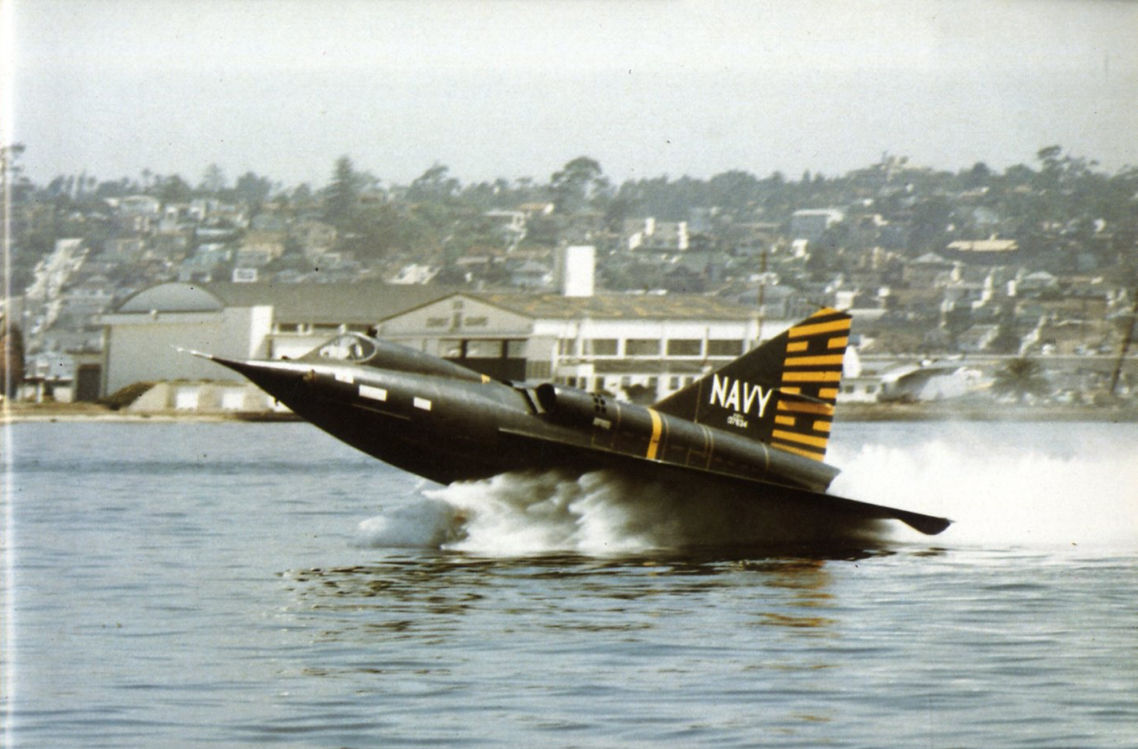
Описание
Страна : США
Год : 1953
Летающая лодка
Одноместный экспериментальный самолет-прототип летающей лодки-истребителя
Convair Model 2 (F2Y Sea Dart)
В начале 1948 года в рамках исследований по двум отдельным программам - несущего корпуса/крыла в "Convair" и подводных крыльев в NACA - началась проработка сверхзвукового истребителя под требования Бюро по аэронавтике ВМС США. Тактико-техническое задание на самолет было сформулировано в октябре 1948 года. В задании оговаривалась возможность самолета выполнять взлет и посадку при высоте волн до 1,52 м, а максимальная скорость полета должна быть не менее М=0,95. По данному заданию разработали два проекта: один - в NACA - на основе концепции подводного крыла, второй - в "Convair" - на основе собственных исследований. Сравнительный анализ выявил преимущества проекта "Convair", сулившего более высокие летные данные (например, более быстрый набор высоты); другой причиной выбора проекта "Convair" стал слишком малый объем данных о поведении подводного крыла на режимах взлета и посадки. Контракт на полномасштабную разработку был заключен с "Convair". В январе 1951 года ВМС США заказали постройку двух прототипов Y2-2 на основе проекта Convair Model 2. Аэродинамически Y2-2 соответствовал перехватчику с дельтовидным крылом F-102 Delta Dagger, но обладал двумя подводными крыльями, а силовая установка состояла из двух ТРДФ Westinghouse XJ46-WE-2. Расчетная максимальная скорость составляла М=1,5, максимальная скороподъемность на уровне моря 9145 м/мин. В ожидании готовности двигателей J46 на самолет установили двигатели меньшей тяги J34-WE-32 и в августе 1951 года обозначение прототипа изменили с Y2-2 на XF2Y-1.
Первый XF2Y-1 собрали в конце 1952 года, в середине декабря начались рулежные испытания, выявившие серьезные вибрации корпуса при движении по воде на скоростях менее 111 км/ч. Тем не менее в январе 1953 года произвели первый отрыв от водной поверхности - самолет набрал высоту 305 м. До официального первого полета, который состоялся в апреле 1953 года, серьезно доработали подводные крылья и внесли ряд изменений в конструкцию аппарата в целом. Два двигателя XJ46 установили на прототип ближе к концу 1953 года, однако расчет на повышенную тягу этих двигателей не оправдался. Выяснилось, что без радикального изменения аэродинамики самолету звуковой барьер не преодолеть. Тогда "Convair" разработала XF2Y-2 с одним подводным крылом и силовой установкой из одного ТРДФ Wright J67 тягой на форсаже 53,38 кН или одного Pratt & Whitney J75 тягой на форсаже 66,72 кН. Необходимость радикального изменения конструкции ставила под вопрос продолжение всей программы, но все же в октябре 1953 году Бюро по аэронавтике ВМС США дало указание завершить второй прототип по стандарту YF2Y-1.
Пока шла постройка первых двух прототипов, в августе 1952 года ВМС заказали 12 предсерийных машин XF2Y-1 с вооружением из четырех 20-мм пушек и 70-мм НАР FFAR, количество которых не оговаривалось. Позже контракт пересмотрели в сторону постройки четырех предсерийных YF2Y-1 и восьми серийных F2Y-1, до закрытия программы F2Y-1 в марте 1954 года объем заказа успел вырасти до 22 самолетов. Реально флот получил пять самолетов (один XF2Y-1, один XF2Y-1 в варианте YF2Y-1 и три изначально построенных YF2Y-1), которые использовались для исследований в области аэродинамики больших скоростей. Первый YF2Y-1 собрали весной 1954 года, а в августе того же года самолет стал первой (и пока единственной) летающей лодкой, преодолевшей звуковой барьер, хотя и в пологом пикировании. Значительный прогресс был достигнут после изменения подводного крыла, поэтому флот принял решение продолжить испытания. Однако во время показательного полета в ноябре 1954 года самолет разрушился в воздухе из-за инициированных летчиком самоколебаний. Катастрофа поставила крест на всей программе Sea Dart. Построили еще три YF2Y-1, два из которых ни разу не поднялись в небо, а на одном самолете отрабатывались варианты с одним и двумя подводными крыльями вплоть до окончательного закрытия программы в 1957 году.
ТАКТИКО-ТЕХНИЧЕСКИЕ ХАРАКТЕРИСТИКИ
Convair Model 2 (XF2Y-1 Sea Dart)
Тип: одноместный экспериментальный самолет-прототип летающей лодки-истребителя
Силовая установка: два ТРДФ Westinghouse J34-WE-32 тягой по 15,2 кН, позже заменены двумя ТРДФ Westinghouse XJ46-WE-2 сухой тягой по 18,5 кН, тяга на форсаже расчетная -27,13 кН, реальная - 25,58 кН
Летные характеристики (расчетные с полноценными двигателями): максимальная скорость на высоте 10 670 м - 1600 км/ч или М=1,5; начальная скороподъемность 9967 м/мин; практический потолок 16 705 м; дальность 826 км
Масса: пустого с ТРДФ J34-5739 кг; максимальная взлетная с ТРДФ J34- 7500 кг, с ТРДФ J46 -9979 кг
Размеры: размах крыла 10,26 м; длина 16,03 м; высота 4,93 м с убранным подводным крылом и 6,32 м - с выпущенным подводным крылом; площадь крыла 52,30 м2
- Описание
Фотографии
-
Aeroplane Monthly 1986-01 / S.Harding - Return of the Sea Dart
The prototype in its prime
-
Aviation Historian 6 / B.Hales-Dutton - A Day of Triumph and Tragedy
The second Sea Dart, YF2Y-1 BuNo 135762, in San Diego Bay. The garish yellow markings were applied to the first and second Sea Darts to enable Convair engineers to assess spray patterns during the type's intensive test programme.
-
Мировая Авиация 94
Ярко окрашенный YF2Y-1 выполняет руление на подводных крыльях. Самолет с технической точки зрения был неудачным, а сценарий боевых действий, в котором подобный истребитель мог быть востребован представить сложно.
-
Aviation Historian 26 / M.Willis - Son of Sea Dart (2)
The sole XF2Y-1, BuNo 137634, transitions from the Pacific Ocean to the Convair ramp at San Diego during the aircraft’s early test programme. Seen here with twin hydro-skis and short jetpipes for its J34 engines, as per its original configuration, the XF2Y-1 was fitted with a single hydro-ski and more powerful XJ46 engines in the summer of 1954.
-
Авиация и Время 2017-02 / А.Чечин - Дротик ядерного века (летающая лодка Sea Dart)
Первый экземпляр «Си Дарта»
-
Aeroplane Monthly 1986-01 / S.Harding - Return of the Sea Dart
The fourth Sea Dart in Balboa Park
-
Авиация и Время 2017-02 / А.Чечин - Дротик ядерного века (летающая лодка Sea Dart)
Установка первого экземпляра «Си Дарта» на трейлер. Осень 1952 г.
-
Авиация и Время 2017-02 / А.Чечин - Дротик ядерного века (летающая лодка Sea Dart)
YF2Y-1 N 1 съезжает с рампы перед испытательным полетом
-
OS 1 / H.Cowin - X-Planes
The intriguing Convair XF2Y-1 Seadart jet-powered hydro-skied interceptor reflected the amount of money available to service procurement officials in the early 1950s. Far too challenging a project to gain serious consideration today, Bu Aer 137634 is seen taxiing out into San Diego Bay. Employing a 60 degree sweep, thin-sectioned delta wing, the Seadart employed a retractable hydro-ski system reminiscent of the World War I Ursinus floatplane. This system was to create numerous problems with the handling of the aircraft on water over the 46 months of F2Y-1 flight testing and underwent several major modifications. A total of three Seadarts were built, the sole XF2Y-1 and two YF2Y-1 pre-production examples, one of which was lost, killing Convair's Charles E. Richbourg, during a Convair family day display on 4 November 1954. The crash cause was attributed to pilot induced oscillation.
-
Aviation Historian 6 / B.Hales-Dutton - A Day of Triumph and Tragedy
Апрель-май 1953г.: 9 апреля Convair XF2Y-1 Sea Dart (фото) выполнил первый полет, после спуска на воду 16 декабря 1952 года в заливе Сан-Диего и рулежных испытаний в начале 1953 года. Впервые в мире боевой самолет с дельтовидным крылом был оснащен убираемыми гидролыжами. Силовая установка состояла из двух турбореактивных двигателей Westinghouse J34. С фирмой "Convair" был заключен контракт на постройку двух прототипов, вслед за которыми предполагалась постройка 11 самолетов с более мощными двигателями для эксплуатационных испытаний.
The sole XF2Y-1 prototype, BuNo 137634, during one of its many water trials. A total of five Sea Darts was built - one XF2Y-1 and four pre-production YF2Y-1S - although the last two of the latter remained engineless and never flew. The XF2Y-1 was initially fitted with a pair of Westinghouse J34s, but was later fitted with two J46s. -
Aeroplane Monthly 1986-01 / S.Harding - Return of the Sea Dart
Амбициозной попыткой создания сверхзвукового гидросамолета-истребителя стал Convair F2Y Sea Dart, оснащенный шасси в виде двух убираемых гидролыж. Построено пять прототипов XF2Y-1, первый из которых взлетел в 1953 году. Несмотря на недостаточную тягу двигателя, самолет превысил скорость звука в пологом пикировании. Программу закрыли в середине 1950-х годов.
The first prototype Sea Dart, 137634, making a high speed run across San Diego Bay. -
Авиация и Время 2017-02 / А.Чечин - Дротик ядерного века (летающая лодка Sea Dart)
«Си Дарт» N 2 на перекатной тележке
Test pilot Chuck Richbourg (seen aft of the cockpit) makes preparations on the San Diego ramp for the ill-fated flight of the first YF2Y-1, BuNo 135762, on November 4, 1954. Note the small wing fences, added only to this machine, to cure a high-speed spanwise migration; and the wing of the R3Y Tradewind at the left of the image. -
Aviation Historian 26 / M.Willis - Son of Sea Dart (2)
A US Navy frogman perches on the wing of the first YF2Y-1, BuNo 135762, at San Diego on November 4, 1954, a matter of minutes before Convair test pilot Chuck Richbourg took off on his final display in the aircraft. Encountering a pilot-induced oscillation (PIO), Richbourg was killed when the aircraft disintegrated during a high-speed low-level run.
-
Aviation Historian 6 / B.Hales-Dutton - A Day of Triumph and Tragedy
Next stop oblivion - Richbourg taxies out for his demonstration flight in BuNo 135762 on November 4, 1954. The jetpipes of the afterburning J46-WE-2 engines were much longer than those of the J34s fitted in the XF2Y-1 prototype.
-
Авиация и Время 2017-02 / А.Чечин - Дротик ядерного века (летающая лодка Sea Dart)
«Си Дарт» в акватории бухты Сан-Диего. 1954 г.
-
Авиация и Время 2017-02 / А.Чечин - Дротик ядерного века (летающая лодка Sea Dart)
«Си Дарт» № 2 на взлете
-
Aviation Historian 6 / B.Hales-Dutton - A Day of Triumph and Tragedy
With Chuck Richbourg at the controls, Sea Dart BuNo 135762 pounds its way into the air from San Diego Harbour on November 4, 1954. Double “hydro-skis” were fitted to all five Sea Darts, although the XF2Y-1 prototype was also extensively tested with a single hydrofoil-type ski, which proved superior, if still not fully satisfactory.
-
Авиация и Время 2017-02 / А.Чечин - Дротик ядерного века (летающая лодка Sea Dart)
XF2Y-1 N 1 в первом испытательном полете. 9 апреля 1953 г.
The first Sea Dart during a test flight in August 1954. -
Air Pictorial 1956-02 / J.Taylor - Aircraft that fail: "Fiascos" do not only happen here
The Convair Sea Dart disintegrated while making a high-speed pass over San Diego bay.
-
Авиация и Время 2017-02 / А.Чечин - Дротик ядерного века (летающая лодка Sea Dart)
«Си Дарт» № 1 перед посадкой. Лыжи полностью выпущены
-
OS 1 / H.Cowin - X-Planes
The Convair XF2Y-1 is shown taxiing onto the beaching ramp. Note the small wheels at the rear of the machine's hydro-skis, supported by a centrally mounted retractable skid under the rear fuselage. Despite nearly four years and 300 flight hours of testing, re-engining from the original two 3.400lb s.t. Westinghouse J34-W-32s to 5.725lb s.t. Westinghouse J46s, plus much ongoing remedial work, the Seadart would have required a major Whitcombe-waisted re-design of its fuselage in order to achieve supersonic flight and was destined to remain in the 'development only' category.
-
Авиация и Время 2017-02 / А.Чечин - Дротик ядерного века (летающая лодка Sea Dart)
«Си Дарт» заходит в док-камеру десантного корабля
-
Авиация и Время 2017-02 / А.Чечин - Дротик ядерного века (летающая лодка Sea Dart)
XF2Y-1 N 3 - экспонат музея в Сан-Диего
-
Aeroplane Monthly 1986-01 / S.Harding - Return of the Sea Dart
Доработанный «Си Дарт» N 1 приводняется на монолыжу
The first Sea Dart on the water.
As part of the Convair-US Navy hydrodynamic research programme, an XF2Y-1 Sea Dart was fitted with a hydro-ski. Among the problems faced by the designers were prevention of water ingestion, low hydrodynamic drag, and stability during take-off and landing. -
Aeroplane Monthly 1986-01 / S.Harding - Return of the Sea Dart
The fifth XF2Y-1, 135765, after restoration but before being primed and painted.
-
Aeroplane Monthly 1986-01 / S.Harding - Return of the Sea Dart
The third Sea Dart, 135763, is currently displayed at the Willow Grove Naval Air Station in incorrect markings.
-
Авиация и Время 2017-02 / А.Чечин - Дротик ядерного века (летающая лодка Sea Dart)
Техническое обслуживание XF2Y-1 N 1. Май 1953 г.
-
Авиация и Время 2017-02 / А.Чечин - Дротик ядерного века (летающая лодка Sea Dart)
Воздушный тормоз - водяной руль
-
Авиация и Время 2017-02 / А.Чечин - Дротик ядерного века (летающая лодка Sea Dart)
Доработанная правая лыжа первого «Си Дарта»
-
Авиация и Время 2017-02 / А.Чечин - Дротик ядерного века (летающая лодка Sea Dart)
Колесо, установленное на лыже, в рабочем положении
-
Авиация и Время 2017-02 / А.Чечин - Дротик ядерного века (летающая лодка Sea Dart)
Хвостовое колесо перекатного шасси «Си Дарта» N 1
-
Авиация и Время 2017-02 / А.Чечин - Дротик ядерного века (летающая лодка Sea Dart)
Катастрофа второго «Си Дарта». 4 ноября 1954 г.
-
Aviation Historian 6 / B.Hales-Dutton - A Day of Triumph and Tragedy
During Richbourg’s low-level pass at some 500kt (900km/h) the YF2Y-1 broke up under severe aerodynamic loads caused by the pitch-divergent oscillations which plagued numerous high-speed projects of the era. Richbourg initially survived the break-up, but was so badly injured that he died shortly afterwards. Sea Dart trials were suspended immediately and, although ski trials later continued, the type never flew at speed again.
-
Air Enthusiast 2003-01 / Round-Out
Convair XF2Y Sea Dart BuNo 137634 in open store at the Smithsonian's Paul Garber facility at Silver Hill, Maryland, in 1989. Clearly, restoration did not take place!
-
Aviation Historian 25 / M.Willis - From Skate to Sea Dart (1)
The futuristic Betta No 1 was a study for a supersonic waterborne attack aircraft, and incorporated a small 60°-swept delta wing, twin retractable hydro-skis and three fuselage-mounted General Electric J53 engines without afterburners fed by a crescent-shaped air intake mounted on the upper surface of the fuselage, plus a small fin.
-
Aviation Historian 26 / M.Willis - Son of Sea Dart (2)
"Naval aviators ... the punch of the air arm" - this early 1950s US Navy recruiting advertisement uses Convair’s Sea Dart to represent the cutting edge of the USA’s military aviation capabilities, and appeal to “a very special kind of men - our naval aviators - born, like aviation itself, in America...”
-
Aviation Historian 26 / M.Willis - Son of Sea Dart (2)
“Engineering to the Nth power” - this contemporary Convair advertisement uses the Sea Dart and the XF-92, referring to the forthcoming F-102 developed from it, to extol the virtues of the delta-wing plan forms of both. Convair optimistically anticipated both being adopted by the military, and, while the F-102 did enter service with the USAF after modification, the Sea Dart never saw service with the US Navy.
Другие самолёты на фотографии: Convair XF-92 - США - 1948
-
Aviation Historian 26 / M.Willis - Son of Sea Dart (2)
An artist’s impression of the SSF in action, as published in the Convair brochure, with Tactical F2Ys sweeping overhead a semi-permanent support base “in sheltered water as near as possible to advance base operations”. Anchored LSTs (tank-landing ships) and CVEs (escort carriers) combine with R3Y-2 Tradewind flying-boats to keep the base supplied.
Другие самолёты на фотографии: Convair P5Y / R3Y Tradewind - США - 1950
-
Aviation Historian 25 / M.Willis - From Skate to Sea Dart (1)
Resembling an exotic deep-sea fish, the Betta No 2 returned to the blended wing/hull configuration developed during the Skate studies, dispensing with the Betta No 1’s hydro-skis. Both Nos 1 and 2 were extensively windtunnel-tested during the first half of 1950.
-
Aviation Historian 26 / M.Willis - Son of Sea Dart (2)
A more detailed view of the two-seat Tactical F2Y from the Convair brochure. The General Electric J79 engines of some 15,000lb+ (6,800kg+)-thrust were the same as those used for the company’s four-engined B-58 Hustler, as well as for the single-engined Lockheed F-104 Starfighter and twin-engined McDonnell F-4 Phantom II.
-
Aviation Historian 25 / M.Willis - From Skate to Sea Dart (1)
Convair’s water babies Skate to Sea Dart, 1946-52
Другие самолёты на фотографии: Convair Skate / Cudda - США - 1949
-
Aviation Historian 26 / M.Willis - Son of Sea Dart (2)
The Convair brochure for the Tactical F2Y included several mission profiles, including this one for a 5hr extended-range “hi-lo-hi” attack mission using the “buddy” refuelling system, in which another F2Y would serve as an air-to-air refuelling tanker. In this profile, 7,700lb (3,500kg) of fuel was to be transferred 575 miles (925km) from the take-off point.
-
Aviation Historian 26 / M.Willis - Son of Sea Dart (2)
THE TACTICAL F2Y & THE SEAPLANE STRIKING FORCE
-
Aviation Historian 26 / M.Willis - Son of Sea Dart (2)
Around 1956 Convair prepared a confidential document offering details of a proposed tactical variant of the F2Y, which would incorporate a second crew position, as shown in this three-view from the brochure. This “son of Sea Dart”, to be used in the tactical support role as part of the SSF, incorporated an internal bomb-bay and a single hydro-ski.
- Фотографии






